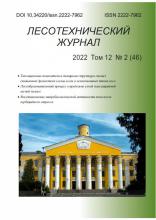Voronezh, Voronezh, Russian Federation
The article is devoted to the monitoring of chemical pollution of coppice oak forests in the green area of Voronezh on the basis of use of oak gallflies as biomonitors. Object of research – the coppice oak forests of green zones along the major highways that are why they are continuously exposed to the entire complex of polluting chemicals in the environment – air and soil, atmospheric precipitation. For conservation and development, as well as the normal functioning and management of forest ecosystems it is extremely important to constantly know the current status of natural objects and parameters, polluting factors. The article investigates chemical pollution of coppice oak forests in the green area of the city of Voronezh from positions of optimized monitoring. Previously, it was found that the most potent source of chemical pollution of coppice oak forests is vehicles, which pollute the environment with combustion products of carbon, but the most important are heavy metals, since the higher plants are recognized as reservoirs for heavy metals contained in the air and soil. Biomonitoring of chemical contamination of vegetation along roads can be effective with higher plants. We investigated the possibility and feasibility of biomonitoring of chemical contamination in coppice oak forests with the help of gallflies, living on oak. We suppose that oak gallflies are promising biomonitor because they have several advantages: a lot of gallflies very sensitive to chemical air pollution and plant hosts, they are sensitive indicator of changes in environmental conditions, which is primarily manifested in the intensity and nature of galeopsifolia processes. Cecidia of gallflies are accessible to observation, they are relatively easily diagnosed in relation to the species; focusing on them, and it is easier to replace changes in the environment than to track those changes directly on the vegetation cover or in geophysical environments.
gallflies, coppice oak forests, green zone, biomonitoring, chemical pollution, heavy metals, bioindication.
Современные леса в черте города отличаются друг от друга по степени сохранности. Наибольшей рекреационной нагрузке подвергаются порослевые дубравы зеленой зоны г. Воронежа. По нашему мнению, рассмотрение проблемы следует начать с определения биологической сущности загрязнения, тем более что последнее рассматривается как особая и важная биологическая проблема [4, 5].
1. Arefyev, Y.F. Monitoring bioraznoobrazia v poroslevyh dubravah ujnoy mestnosti Centralnogo Chernozemya [Monitoring of biodiversity in coppice oak forests in the southern area of the Central Black Soil Region] Y.F. Arefyev, A.V. Drozdova // Voprosy regionalnoy economiky [Problems of regional ecology]. - Tambov, Publishing House of the TSU named after GR Derzhavin, 1998, - pp. 25-26. (In Russian). EDN: https://elibrary.ru/UBTMGV
2. Goodman, G. T. and T. M. Roberts Plants and soils as indicators of metals in the air. Nature, London. 231, 1971. - pp..287-292.
3. Hawksworth D. L. and F. Rose Lichens as Pollution Monitors. Edward Arnold Publishers, London, 1976. - 59p.
4. Heggestad H. E., Menser H. A. Leaf spot-sensetive tobacco strain Bel -W 3, a biological indicator of the air pollutant ozone // Phytopathology, 52, 1962. - 735 p.
5. Heggestad H. E. and Darley E. F. Plants as indicators of the air pollutants ozone and PAN. Proc. Firsturopean Congr., Influence Air pollution, Plants and Animals, Wageningen, Netherlands, 1968. - 329 p.
6. Manning W. J., Feder W. A. Biomonitoring Air Pollutants with Plants. London: Applied science publishers LTD. - 140 p.
7. Roberts B. R. The response of field - grown white pine seedlings to different sulphur dioxide enwironments// Environ. Pollut.11, 1976. - . pp. 175-180.
8. Ruhling A. and G. Tyler An ecological approach to the lead problem // Bot. Notiser., 121, 1968. - pp. 321-342.
9. Ruhling A. and G. Tyler Sorption and retention of heavy metals in the woodland moss Hylocomium splendens. (Hedw.) // Br. Et. Sch., Oikos., 21, 1970. - pp. 445-445.
10. Ruhling A. and G. Tyler Ecology of heavy metals. A regional and historical study // Bot. Notiser. 122, 1969. - pp. 248-259.
11. Wallin T. Deposition of airborne mercury from six Swedish chloral kali plants surveyed by moss analysis // Environ. Pollut. 10, 1976. - pp. 101-114.
12. Zimdahl R. L. Entry and movement in vegetation of lead derived from air and soil sources. // J. Air Poll. Control Assoc., 26, 1976. - pp. 655-660.
13. Feder W. A. and W. J. Manning Living plants as indicators and monitors // In Handbook of Methology for the Assessment of Air Pollution Effects on Vegetation / Air Pollution Assotiation, Pittsburgh, PA, 1979. - pp. 9-14.












